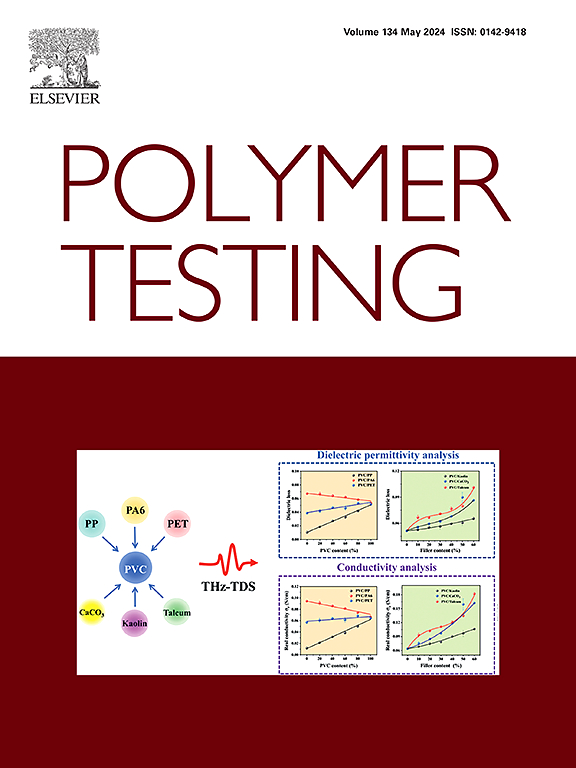Fungal decay-provoked degradation of cross-linking networks in phenol-formaldehyde adhesive: From fragmentation process towards damaged mechanical robustness
IF 5
2区 材料科学
Q1 MATERIALS SCIENCE, CHARACTERIZATION & TESTING
引用次数: 0
Abstract
The mechanical robustness of structural adhesives as represented by phenol formaldehyde (PF) adhesive is vital for the safe service of engineered wood/bamboo products facing environmental aggressors. Here, fungal decay-provoked hazard towards the mechanical robustness of PF adhesive was demonstrated, which was usually overlooked in previous works. Obtained results proved that the white rot (Trametes versicolor, T. versicolor) and brown rot (Gloeophyllum trabeum, G. trabeum) fungus can both grow on the surface of cured commercial PF adhesive. An evident oxidization can only be observed on the T. versicolor-decayed PF adhesive, as along with the appearance of 2,6-bis(1,1-dimethylethyl)-1,4-benzenediol after decay. It further demonstrated the ruptured and oxidized cross-linking structures. The evident degradation of PF adhesive can be assigned to the favored activity of laccase (40.9 U mL−1) and lignin peroxidase (60.5 U mL−1) during the decay of T. versicolor. The elastic modulus and hardness of PF adhesive reduced by over 31.6 % and 50.2 %, respectively, which is also accompanied by the elevation in the creep deformation (45.4 %), after a 40-day T. versicolor decay. This work revealed the decay-sensitivity of PF adhesive, and the cleavage of cross-linking structures is the major trigger for the degraded mechanical robustness of PF adhesive after decay.
真菌腐烂引起苯酚-甲醛胶粘剂中交联网络的降解:从破碎过程到受损的机械稳健性
以苯酚甲醛(PF)粘合剂为代表的结构粘合剂的机械坚固性对于面对环境侵害的工程木/竹产品的安全使用至关重要。在此,我们展示了真菌腐烂对苯酚甲醛胶粘剂机械坚固性的危害,这在以往的研究中通常被忽视。研究结果证明,白腐菌(Trametes versicolor,T. versicolor)和褐腐菌(Gloeophyllum trabeum,G. trabeum)都能在固化的商用聚苯乙烯粘合剂表面生长。只有在 T. versicolor 腐烂的 PF 粘合剂上才能观察到明显的氧化现象,腐烂后还会出现 2,6-双(1,1-二甲基乙基)-1,4-苯二酚。这进一步证明了交联结构的破裂和氧化。PF 粘合剂的明显降解可归因于 T. versicolor 腐烂过程中漆酶(40.9 U mL-1)和木质素过氧化物酶(60.5 U mL-1)的活性。经过 40 天的 T. versicolor 腐化后,PF 粘合剂的弹性模量和硬度分别降低了 31.6% 和 50.2%,蠕变变形也增加了 45.4%。这项工作揭示了 PF 粘合剂对腐烂的敏感性,交联结构的裂解是 PF 粘合剂在腐烂后机械坚固性下降的主要诱因。
本文章由计算机程序翻译,如有差异,请以英文原文为准。
求助全文
约1分钟内获得全文
求助全文
来源期刊

Polymer Testing
工程技术-材料科学:表征与测试
CiteScore
10.70
自引率
5.90%
发文量
328
审稿时长
44 days
期刊介绍:
Polymer Testing focuses on the testing, analysis and characterization of polymer materials, including both synthetic and natural or biobased polymers. Novel testing methods and the testing of novel polymeric materials in bulk, solution and dispersion is covered. In addition, we welcome the submission of the testing of polymeric materials for a wide range of applications and industrial products as well as nanoscale characterization.
The scope includes but is not limited to the following main topics:
Novel testing methods and Chemical analysis
• mechanical, thermal, electrical, chemical, imaging, spectroscopy, scattering and rheology
Physical properties and behaviour of novel polymer systems
• nanoscale properties, morphology, transport properties
Degradation and recycling of polymeric materials when combined with novel testing or characterization methods
• degradation, biodegradation, ageing and fire retardancy
Modelling and Simulation work will be only considered when it is linked to new or previously published experimental results.
 求助内容:
求助内容: 应助结果提醒方式:
应助结果提醒方式:


